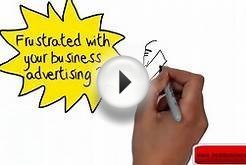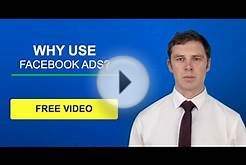“If you build it, they will come” may have worked in the movie Field of Dreams, but if that’s your advertising motto your business won’t last long. Whether your small business is online or offline, you need to communicate your existence to your target audience if you want to sell anything.
“Word of mouth is all you need” is another awful adage for your business. Word of mouth may keep you afloat at first, but it will limit you when it comes to growing your business in the long term. The sad truth is that customers tend to talk a lot more about bad experiences than good ones.
Or is “Location, location, location” your rallying cry for your bricks and mortar business? After a time you’ll find that location isn’t everything. While it certainly has an influence, businesses can succeed or fail in any location. It’s best not to rely on location to bring you all your business.
The competition is fierce out there. As a small business owner, you’re up against not only other small businesses, but giants like Amazon, Target, Walmart, and eBay. Building a great product or service just isn’t enough; you need effective advertising to survive.
Luckily, the Internet has made reaching your target audience, no matter where they may be, much easier and cheaper than before. Instead of spending hundreds or thousands on a TV commercial or an ad in the yellow pages, you can spend just a few bucks advertising on websites and social media.
But the world of online advertising can be overwhelming for a busy small business owner to navigate. Should you invest in Google AdWords or Facebook ads? How much should you bid? And that’s not even getting into all the confusing jargon and acronyms you need to know to buy an ad, like CPM, CTR, PPC.
That’s why we put together this graphic guide to getting started with online advertising. Check out the basics below, so you can focus on getting the word out about your small business!
Advertising online can be overwhelming, but it doesn’t have to be. Use this quick beginner’s guide to learn more about the various advertising options, so you can draw new traffic and customers to your website.
The Basics
Before you can launch a campaign, you need to understand some of the most common terms used in the industry.
Pay Per Click (PPC) Under this model, advertisers choose a maximum amount they are willing to pay each time a user clicks on their ad. Cost Per Click (CPC) This refers to the cost of each click an advertiser pays once a user clicks an ad in their PPC campaign. Example: If an advertiser bids up to $1 for a keyword on his PPC campaign, but wins the bid at $0.99, then the CPC becomes $0.99. Cost Per Action (CPA) What the advertisers pay when their ad click leads to action, such as a sale. Cost Per Thousand (CPM) The cost for 1, 000 ad impressions (displays) – not clicks. Example: If the rate is $2 per 1, 000 impressions, advertisers pay that amount regardless of how many times the ad was clicked. Click Through Rate (CTR) A comparison of the number of people who view your ads, compared to the number of people who click your ads – expressed as a percentage. Conversion Rate: Used to compare the total number of website visitors to the overall goal of the ad. This could be: Paying customers New subscribers New users Contextual Advertising: Advertisers create ads that are then displayed on websites that have content targeted to the ad content. Example: If an advertiser runs an ad for his website that sells dog leashes, his ad may show up on any number of websites within the ad network that discuss dogs, and more specifically, dog leashes. Return on Investment (ROI) Evaluates performance and measures profitability by dividing profit by cost.Social Media Advertising
Advertise your products/services on social media websites such as Facebook and Twitter.
Here is a look at the basic process for Facebook and Twitter.
Once you get started, there are a variety of options for you to choose from to completely customize you campaign. Facebook Ads: Ads shown on the sidebar of a Facebook account when a user is logged in. The ROI for retail Facebook advertisers is 152%. Advertisers: Choose to promote a post on their page/profile, or a website. Choose who to target based on a number of demographics, including: Age Gender Location Interests Are told how far the ad could reach. Set a budget, daily or lifetime maximum. Advertisers can run ad on a specific set of dates, or choose to run the ad continuously until the budget is reached. Choose to pay for clicks, or for impressions. Pros: Cost-effective ($1 per day minimum spend) Facebook users aren’t overwhelmed with ads Many options for custom audiences Cons: Investing in Facebook “fans” doesn’t always translate to customers Time consuming Twitter Ads: Ads shown in the sidebar of a Twitter account when a user is logged in. Advertisers can choose to promote: Profiles Tweets Trends (hashtags) Can set a daily budget for the campaign, and the ad stops running when the budget is met. Advertisers bid the maximum price they are willing to pay, but are often charged much less. Pros: Automatic targeted audience Users can interact with ad (retweet, click, reply, etc.) Cons: Targeted audience is not always relevant Users may overlook due to the distraction of their Twitter feedGoogle Adwords
Based on a PPC model, advertisers set a budget, or the maximum amount of money they are willing to spend per day, and a maximum CPC bid.
Advertisers bid on keywords relevant to their website/product/service. Each time a search with that keyword is run, Google chooses a pool of ads from those that rank high enough on the bid. Ads are chosen on a number of factors, including: Bid amount: The amount you’re willing to pay for the ad. Quality Score: An estimate of an ad’s relevance based on keywords, landing page, and the ad itself. A higher quality score can surpass a higher bid amount. Winning advertisers only pay when their ad is clicked. The ad stops running when the budget is hit. In 2012, Google Adwords had more than 1.2 million users. Pros: Easy to measure your campaign (CTR, conversions, conversion rate, CPC, CPA, ROI, etc.) Only pay for clicks, not the ad itself Users receive most relevant ads due to the Ad Auction Highly targeted Has the most reach Cons: Small ads (3 lines + your URL)














